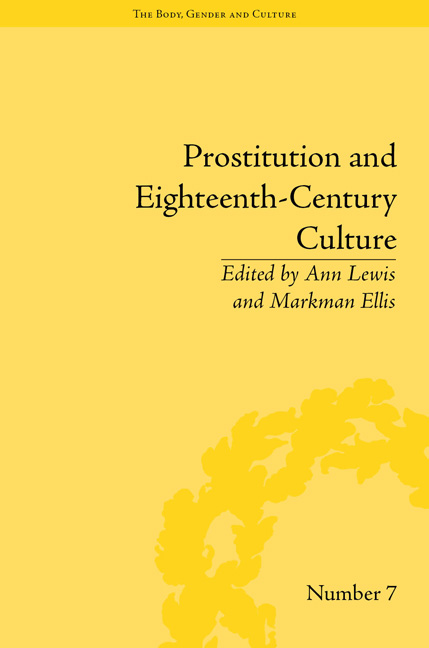Book contents
- Frontmatter
- CONTENTS
- Acknowledgements
- List of Contributors
- List of Figures and Tables
- Introduction: Venal Bodies – Prostitutes and Eighteenth-Century Culture
- Part I (Auto)Biographical and Classificatory Fictions: Madams, Courtesans, Whores
- Part II Visibility and Theatricality: Fiction, Image and Performance
- Part III The Magdalen House: Marriage, Motherhood, Social Reintegration
- 10 Figuring the London Magdalen House: Mercantilist Hospital, Sentimental Asylum or Proto-Evangelical Penitentiary?
- 11 Mothers and Others: Sexuality and Maternity in The Histories of Some of The Penitents in the Magdalen-House (1760)
- Part IV Wider Perspectives: Constructing the Prostitute in Social History
- Notes
- Index
11 - Mothers and Others: Sexuality and Maternity in The Histories of Some of The Penitents in the Magdalen-House (1760)
from Part III - The Magdalen House: Marriage, Motherhood, Social Reintegration
- Frontmatter
- CONTENTS
- Acknowledgements
- List of Contributors
- List of Figures and Tables
- Introduction: Venal Bodies – Prostitutes and Eighteenth-Century Culture
- Part I (Auto)Biographical and Classificatory Fictions: Madams, Courtesans, Whores
- Part II Visibility and Theatricality: Fiction, Image and Performance
- Part III The Magdalen House: Marriage, Motherhood, Social Reintegration
- 10 Figuring the London Magdalen House: Mercantilist Hospital, Sentimental Asylum or Proto-Evangelical Penitentiary?
- 11 Mothers and Others: Sexuality and Maternity in The Histories of Some of The Penitents in the Magdalen-House (1760)
- Part IV Wider Perspectives: Constructing the Prostitute in Social History
- Notes
- Index
Summary
The crucial role that the prostitute played in the construction of bourgeois femininity in the second half of the eighteenth century has received considerable scholarly attention. Accounts of this uneasy relationship have traditionally focused upon the prostitute's symbolic function as the domestic woman's degraded other: a figure against which virtuous femininity and sexuality were defined and upon whose abjection the middle-ranking woman's respectability was parasitically dependent. More recent studies, such as those by Katherine Binhammer, Ruth Perry and Laura J. Rosenthal, have painted a more complex picture that emphasizes the disquieting similarities that eighteenth-century commentators observed between whore and wife and between sex for money and the legalized prostitution that was, in Binhammer's words, ‘mercenary marriage’. If, as Perry suggests, it became increasingly difficult by the mid-eighteenth century ‘to mention wives without mentioning prostitutes or prostitutes without mentioning wives’, then it was, in part, because the prostitute spoke to readers’ fears about themselves as much as to their fears of others. Although, as Rosenthal argues, prostitutes were, in many ways, ‘set apart from other women’ throughout the period, ‘in other ways, however, they came to seem more and more like everyone else’. Testifying to the pressures under which virtue and selfhood were put by a modern, commercial society, the prostitute was not only subject to anxious displacement, but also a provocation to uncomfortable self-recognition.
- Type
- Chapter
- Information
- Prostitution and Eighteenth-Century CultureSex, Commerce and Morality, pp. 157 - 170Publisher: Pickering & ChattoFirst published in: 2014



